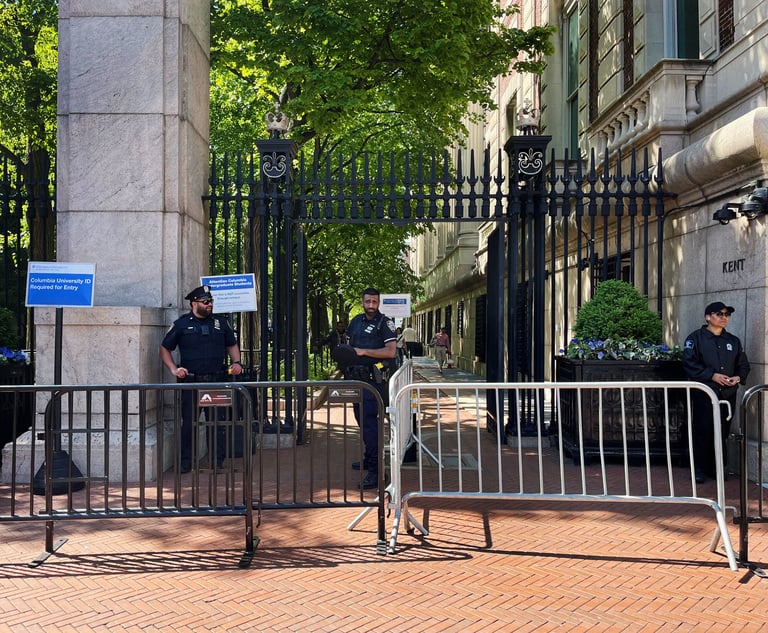Ahead of the Curve: Here Come The Undergraduate Law Degrees
This week's Ahead of the Curve examines the early success of the University of Arizona's B.A. in Law, which will finally get some competition next year. Plus, is a second clerkship one too many? At least one judge thinks so.
July 09, 2019 at 03:42 PM
7 minute read
Welcome back to Ahead of the Curve. I'm Karen Sloan, legal education editor at Law.com, and I'll be your host for this weekly look at innovation and notable developments in legal education.
This week, I'm checking in on the University of Arizona James E. Rogers College of Law's five-year-old B.A. in law program, which is the first in the country but will get some new competition next year from the State University of New York at Buffalo Law School. Next up is a look at an article from federal appellate judge Gregg Costa that argues against the recent trend of lawyers doing two or more clerkships.
Please share your thoughts and feedback with me at [email protected] or on Twitter: @KarenSloanNLJ

B.A. in Law Proves Popular
At the end of June, the State University of New York at Buffalo Law Schoolannounced its plans to launch an undergraduate degree in law, taught by the law faculty. It will become just the second such program in the United States. (Law is an undergraduate degree in most other common-law countries.)
This got me thinking about the University of Arizona James E. Rogers College of Law, which became the first to offer an undergraduate law degree in the U.S. in 2014. The goal of the program is to expand access to legal education and help prepare students for law-adjacent careers, as well as allow them to explore whether they want to pursue a full law degree—the same reasons officials at Buffalo have said they are launching a B.A. in law. So are undergraduate law programs the wave of the future?
In order to better understand the potential of such programs, I reached out to Arizona law dean Marc Miller to find out how his five-year-old B.A. in Law is going. As luck would have it, he was at the Ocean University of China in Quingdao,where the program has expanded in a partnership that allows Chinese law students to earn undergraduate degrees in both Chinese and U.S. law. Despite his busy schedule, Miller kindly clued me in via email on how it's going. Here's what he said:
“The B.A. in Law program is a jewel. It has succeeded on every dimension we hoped, including being a dramatic pathway for diversity, broadly understood.”
Some quick facts:
➤➤The program enrolled about 1,200 students in the 2018-19 academic year. (For context, Arizona has about 340 J.D. students.) About 800 are in the U.S. with most completing the program in person on the Tucson campus, but about 100 people are taking the program fully online. Another 400 are in the aforementioned Ocean University dual degree program. And 15 are in a second dual degree program offered with the American University of Phnom Penh in Cambodia.
➤➤Thus far, 60 percent of students in the B.A. program have been women, and 55 percent have been racially diverse. Additionally, a third identify as first-generation college students.
➤➤About 40 percent of the students from the early classes of the B.A. program have gone on to law school or other graduate-level education. That figure demonstrates that the program is designed to lead to a broad array of career possibilities, and not just to funnel students on to law school, according to Miller.
I'll be honest. That 1,200 enrollment figure surprised me. I had been monitoring the program since it launched, but I didn't realize that it had grown so much so quickly. That would indicate that Arizona has tapped into an area of demand among undergraduates, though it's hard to know whether its program has been so popular because it's unique or because that level of demand exists on every university campus.
Arizona's B.A. in Law is offered in conjunction with the university's School of Government and Public Policy, and Miller stressed that students take a wide breadth of coursework—not just law. Adding an undergraduate law degree has also helped the school forge global partnerships, given that most law students around the world are undergraduates, he added.
Another interesting thread that emerged from my correspondence with Miller is the idea of an undergraduate law program being a promising alternate way to admit students into the graduate program: The law school would have grades from courses taught by law professors themselves with which to evaluate candidates. Admitting students that way is not possible at the moment because the American Bar Association currently requires schools to use a standardized test in admissions. (Recall that Arizona kicked off the trend of law schools accepting GRE scores.) That is to say, Arizona can take those grades from its B.A. program into consideration, but applicants still have to take the LSAT or GRE as it stands. Arizona is currently testing to see if there is a correlation between performance in the B.A. and J.D. programs.
My thoughts: As I said before, 1,200 is a lot of students—that would be about the seventh largest among J.D. programs in the U.S. And that translates into a lot of tuition dollars. It's not a coincidence that the B.A. program was announced in 2014, when J.D. enrollments nationwide were in a tailspin and law schools were slashing budgets right and left. I asked Miller how the B.A. program has performed from a financial standpoint. He said it has become “an important revenue generator for the law school.” But he added that the program would have been a good idea even at a time when the law school didn't need to diversify its revenue streams. Are other schools going to follow suit? Miller suspects so.
|
Clerkship Gluttony
I've been following the rollout of the new Federal Clerk Hiring Plan, which kicked off last month. (You can read my coverage here and here.) But a different clerk issue caught my eye recently. Specifically: This essay from Gregg Costa in Judicature, a publication on the judiciary put out by Duke Law School's Center for Judicial Studies. (Costa sits on the U.S. Court of Appeals for the Fifth Circuit.)
It's a quick and easy read—I suggest talking a look. But here's the underlying premise: This relatively recent trend of young lawyers with two, three or even four clerkships on their resumes is not a good thing for the legal profession. Costa's argument is straightforward. A limited number of judges are on the bench, and clerkships are formative experiences in the development of legal minds. When judges hire clerks who have already had that training under a different judge, it means that fewer young lawyers overall get access to that important training opportunity. So a small number of lawyers will emerge from the process with extensive training under multiple judges, while more young lawyers will get shut out completely.
Costa also argues that multiple clerkships offer diminishing rewards and potential problems. Judges may come to rely too heavily on those experienced clerks, rather than using them in a strictly advisory role. And once new lawyers gain the fundamental research, analysis and writing skills from their first clerkship, the primary benefit from subsequent clerkships is largely an additional mentor relationship, Costa writes. Food for thought…
||
Extra Credit Reading
Could Harvard Law School's Bruce Mann be the first First Gentleman? What about the University of Baltimore School of Law's John Bessler? Both are married to women vying for the 2020 Democratic nomination.
Fordham University School of Law has launched a new Legal Education and Access Program designed to help bring first-generation college students to law school.
This isn't a legal education story per se, but check out this essay from Reed Smith partner Mark Goldstein on what happened after he publically disclosed his struggle with depression.
Thanks for reading Ahead of the Curve. Sign up for the newsletter and check out past issues here.
I'll be back next week with more news and updates on the future of legal education. Until then, keep in touch at [email protected]
This content has been archived. It is available through our partners, LexisNexis® and Bloomberg Law.
To view this content, please continue to their sites.
Not a Lexis Subscriber?
Subscribe Now
Not a Bloomberg Law Subscriber?
Subscribe Now
NOT FOR REPRINT
© 2024 ALM Global, LLC, All Rights Reserved. Request academic re-use from www.copyright.com. All other uses, submit a request to [email protected]. For more information visit Asset & Logo Licensing.
You Might Like
View All



Trending Stories
- 1Friday Newspaper
- 2Judge Denies Sean Combs Third Bail Bid, Citing Community Safety
- 3Republican FTC Commissioner: 'The Time for Rulemaking by the Biden-Harris FTC Is Over'
- 4NY Appellate Panel Cites Student's Disciplinary History While Sending Negligence Claim Against School District to Trial
- 5A Meta DIG and Its Nvidia Implications
Who Got The Work
Michael G. Bongiorno, Andrew Scott Dulberg and Elizabeth E. Driscoll from Wilmer Cutler Pickering Hale and Dorr have stepped in to represent Symbotic Inc., an A.I.-enabled technology platform that focuses on increasing supply chain efficiency, and other defendants in a pending shareholder derivative lawsuit. The case, filed Oct. 2 in Massachusetts District Court by the Brown Law Firm on behalf of Stephen Austen, accuses certain officers and directors of misleading investors in regard to Symbotic's potential for margin growth by failing to disclose that the company was not equipped to timely deploy its systems or manage expenses through project delays. The case, assigned to U.S. District Judge Nathaniel M. Gorton, is 1:24-cv-12522, Austen v. Cohen et al.
Who Got The Work
Edmund Polubinski and Marie Killmond of Davis Polk & Wardwell have entered appearances for data platform software development company MongoDB and other defendants in a pending shareholder derivative lawsuit. The action, filed Oct. 7 in New York Southern District Court by the Brown Law Firm, accuses the company's directors and/or officers of falsely expressing confidence in the company’s restructuring of its sales incentive plan and downplaying the severity of decreases in its upfront commitments. The case is 1:24-cv-07594, Roy v. Ittycheria et al.
Who Got The Work
Amy O. Bruchs and Kurt F. Ellison of Michael Best & Friedrich have entered appearances for Epic Systems Corp. in a pending employment discrimination lawsuit. The suit was filed Sept. 7 in Wisconsin Western District Court by Levine Eisberner LLC and Siri & Glimstad on behalf of a project manager who claims that he was wrongfully terminated after applying for a religious exemption to the defendant's COVID-19 vaccine mandate. The case, assigned to U.S. Magistrate Judge Anita Marie Boor, is 3:24-cv-00630, Secker, Nathan v. Epic Systems Corporation.
Who Got The Work
David X. Sullivan, Thomas J. Finn and Gregory A. Hall from McCarter & English have entered appearances for Sunrun Installation Services in a pending civil rights lawsuit. The complaint was filed Sept. 4 in Connecticut District Court by attorney Robert M. Berke on behalf of former employee George Edward Steins, who was arrested and charged with employing an unregistered home improvement salesperson. The complaint alleges that had Sunrun informed the Connecticut Department of Consumer Protection that the plaintiff's employment had ended in 2017 and that he no longer held Sunrun's home improvement contractor license, he would not have been hit with charges, which were dismissed in May 2024. The case, assigned to U.S. District Judge Jeffrey A. Meyer, is 3:24-cv-01423, Steins v. Sunrun, Inc. et al.
Who Got The Work
Greenberg Traurig shareholder Joshua L. Raskin has entered an appearance for boohoo.com UK Ltd. in a pending patent infringement lawsuit. The suit, filed Sept. 3 in Texas Eastern District Court by Rozier Hardt McDonough on behalf of Alto Dynamics, asserts five patents related to an online shopping platform. The case, assigned to U.S. District Judge Rodney Gilstrap, is 2:24-cv-00719, Alto Dynamics, LLC v. boohoo.com UK Limited.
Featured Firms
Law Offices of Gary Martin Hays & Associates, P.C.
(470) 294-1674
Law Offices of Mark E. Salomone
(857) 444-6468
Smith & Hassler
(713) 739-1250








